2022年英语中考语法复习课件-介词(共有PPT32张)
文档属性
| 名称 | 2022年英语中考语法复习课件-介词(共有PPT32张) | 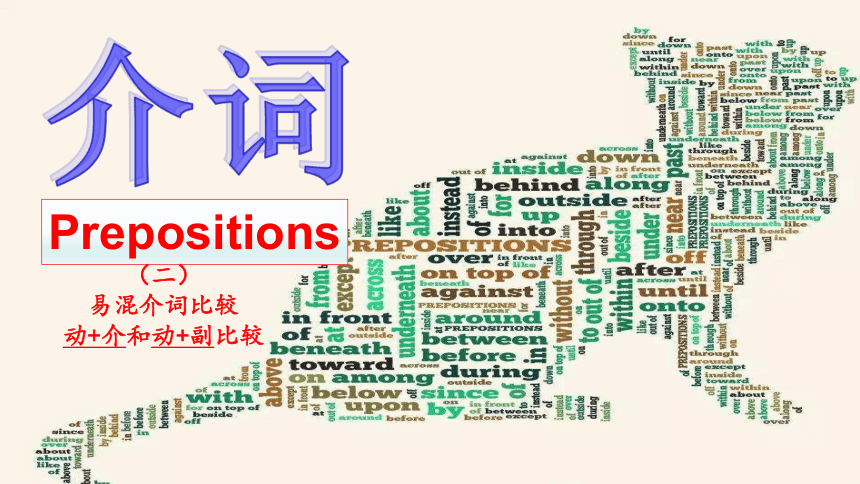 | |
| 格式 | pptx | ||
| 文件大小 | 543.1KB | ||
| 资源类型 | 教案 | ||
| 版本资源 | 通用版 | ||
| 科目 | 英语 | ||
| 更新时间 | 2022-04-12 08:10:45 | ||
图片预览

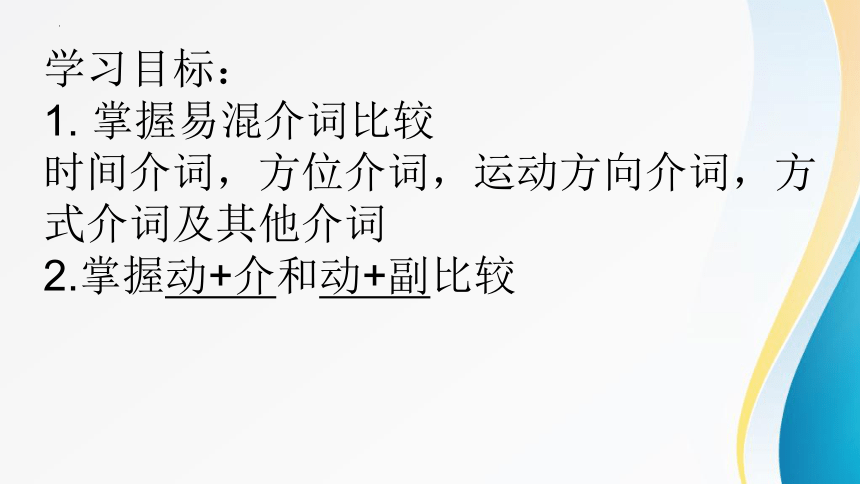
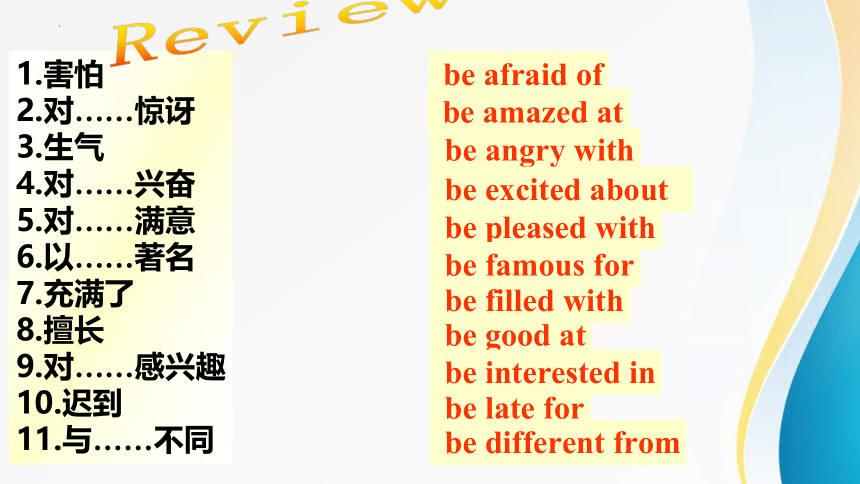

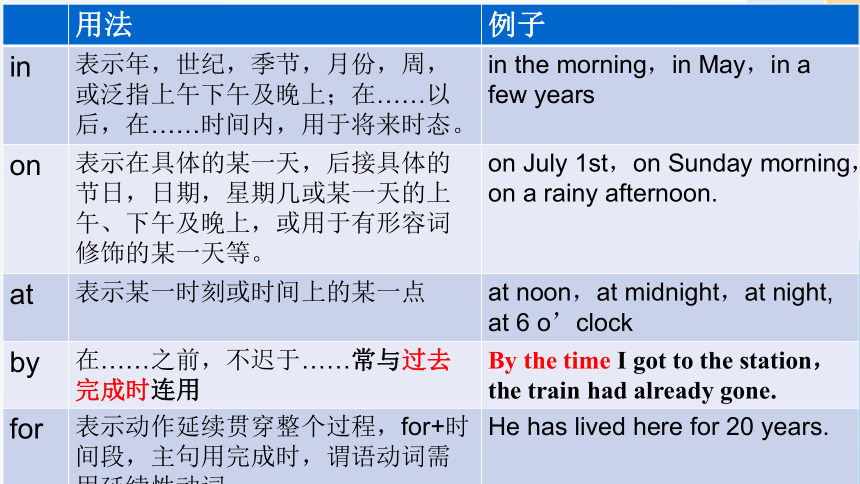
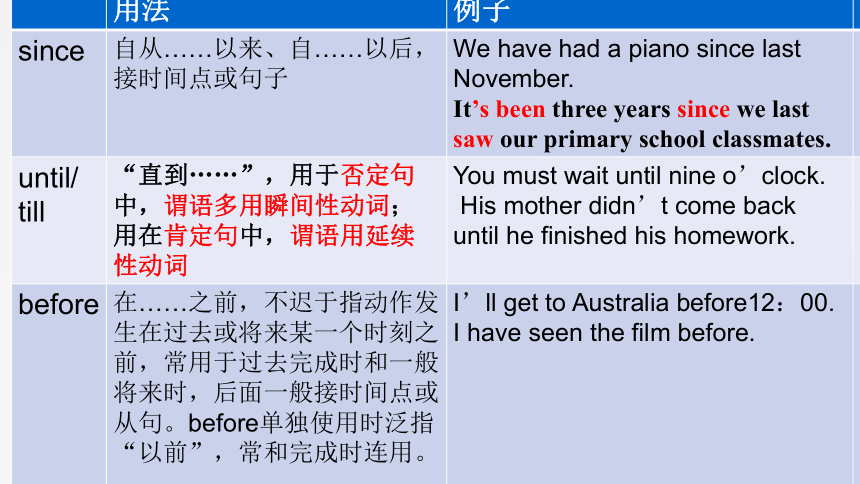
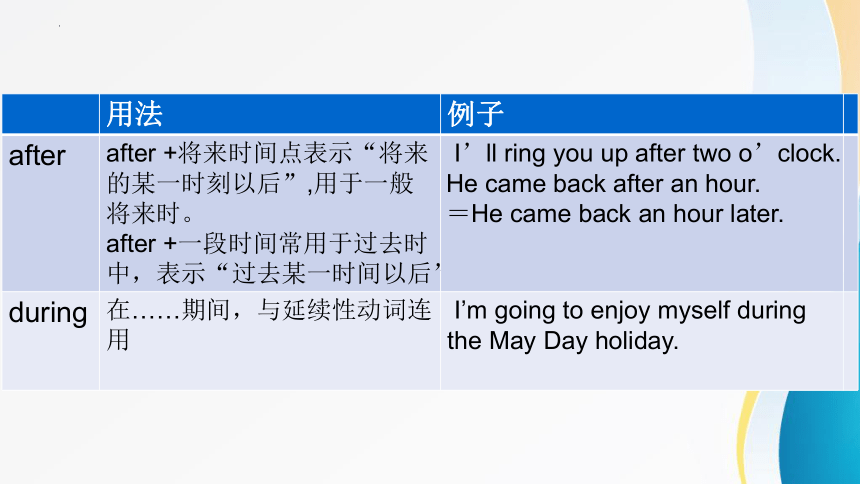
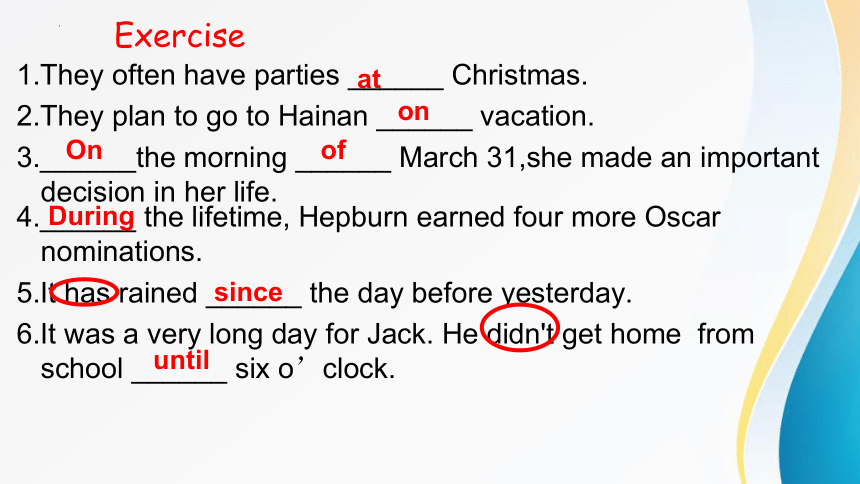


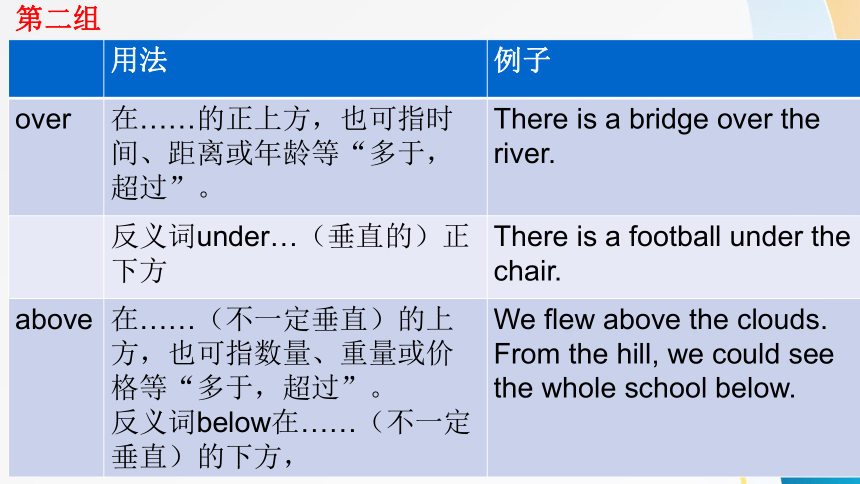
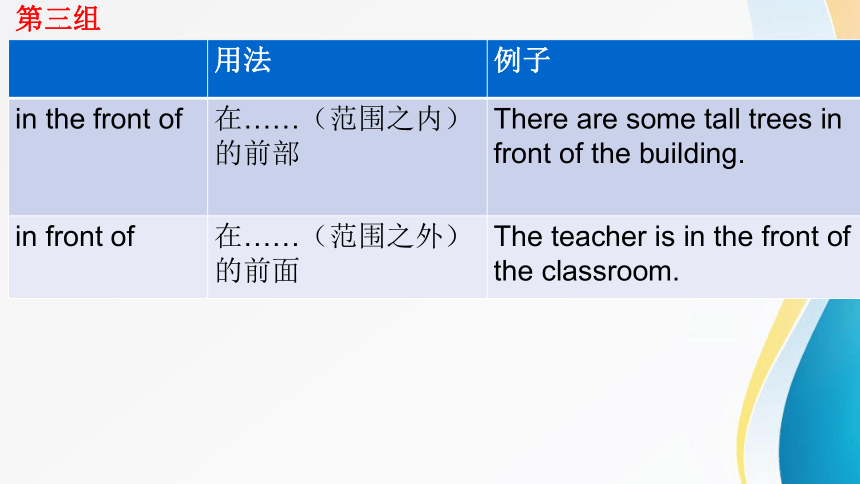
文档简介
(共32张PPT)
介词
Prepositions
(二)
易混介词比较
动+介和动+副比较
学习目标:
1. 掌握易混介词比较
时间介词,方位介词,运动方向介词,方式介词及其他介词
2.掌握动+介和动+副比较
1.害怕
2.对……惊讶
3.生气
4.对……兴奋
5.对……满意
6.以……著名
7.充满了
8.擅长
9.对……感兴趣
10.迟到
11.与……不同
be afraid of
be amazed at
be angry with
be excited about
be pleased with
be famous for
be filled with
be good at
be interested in
Review
be late for
be different from
易混介词比较
(一)表示时间的介词
用法 例子
in 表示年,世纪,季节,月份,周,或泛指上午下午及晚上;在……以后,在……时间内,用于将来时态。 in the morning,in May,in a few years
on 表示在具体的某一天,后接具体的节日,日期,星期几或某一天的上午、下午及晚上,或用于有形容词修饰的某一天等。 on July 1st,on Sunday morning,on a rainy afternoon.
at 表示某一时刻或时间上的某一点 at noon,at midnight,at night, at 6 o’clock
by 在……之前,不迟于……常与过去完成时连用 By the time I got to the station,the train had already gone.
for 表示动作延续贯穿整个过程,for+时间段,主句用完成时,谓语动词需用延续性动词 He has lived here for 20 years.
用法 例子
since 自从……以来、自……以后,接时间点或句子 We have had a piano since last November. It’s been three years since we last saw our primary school classmates.
until/ till “直到……”,用于否定句中,谓语多用瞬间性动词;用在肯定句中,谓语用延续性动词 You must wait until nine o’clock. His mother didn’t come back until he finished his homework.
before 在……之前,不迟于指动作发生在过去或将来某一个时刻之前,常用于过去完成时和一般 将来时,后面一般接时间点或从句。before单独使用时泛指“以前”,常和完成时连用。 I’ll get to Australia before12:00. I have seen the film before.
用法 例子
after after +将来时间点表示“将来的某一时刻以后”,用于一般将来时。 after +一段时间常用于过去时中,表示“过去某一时间以后” I’ll ring you up after two o’clock. He came back after an hour. =He came back an hour later.
during 在……期间,与延续性动词连用 I’m going to enjoy myself during the May Day holiday.
1.They often have parties ______ Christmas.
2.They plan to go to Hainan ______ vacation.
3.______the morning ______ March 31,she made an important decision in her life.
Exercise
at
on
On
4.______ the lifetime, Hepburn earned four more Oscar nominations.
5.It has rained ______ the day before yesterday.
6.It was a very long day for Jack. He didn't get home from school ______ six o’clock.
since
During
until
of
易混介词比较
(二)表示方位的介词
用法 例子
in 表示“在……里面”指在某一范围之内表示A地属于B地;也可以表示在某个较大的地方(国家,城市等) in China, in the dark, in the wall, in the tree
on 表示在某物或某地的表面上,与物体接触;也可以指两地接壤。 on the tree,on the wall,on the south of Hainan.
at 表示小地点前 He is sitting at the desk/table.
to 表示“在某范围以外” Japan is to the east of China.
第一组
用法 例子
over 在……的正上方,也可指时间、距离或年龄等“多于,超过”。 There is a bridge over the river.
反义词under…(垂直的)正下方 There is a football under the chair.
above 在……(不一定垂直)的上方,也可指数量、重量或价格等“多于,超过”。 反义词below在……(不一定垂直)的下方, We flew above the clouds.
From the hill, we could see the whole school below.
第二组
用法 例子
in the front of 在……(范围之内)的前部 There are some tall trees in front of the building.
in front of 在……(范围之外)的前面 The teacher is in the front of the classroom.
第三组
用法 例子
between 表示“在……(两者)之间”,常与and连用 They planted a lot of trees between the two buildings.
among 表示“在……(三者或三者以上的人和物)之间” Tom has always been popular among his classmates.
第四组
第五组
用法
near 在……附近,
next to 紧挨着……,
around 在……周围,
by 在……旁边,
用法
behind 在……(范围之外)的后面
at the back of 在……(范围之内)的后部
第六组
易混介词比较
(三)表示运动方向的介词
用法 例子
across 表示“穿过”物体表面,或“横过” walk across the street
through 表示在物体里面“穿过”,或“纵穿过” go through the gate
along 表示“沿着” go along the street
past 表示从旁边经过 go past the bank.
第一组
用法 例子
to 表示“到,朝,向”(强调目的地)
We came to the cinema at last.
towards 表示“朝,向”(强调方向) They saw a car coming towards him.
第二组
易混介词比较
(四)表示方式的介词
用法 例子
by 用……交通工具,其后不用冠词。 “凭借某种手段” by bus, by plane
It’s helpful to learn words by remembering them in groups.
in 使用某种语言或材料 The little boy can introduce himself in English.
with 用……工具(指具体有形的工具) You have to cut it up with and eat it with a fork.
on 通过,用 I don’t want to talk about it on the phone.
易混介词比较
(五)其他易混介词
用法 例子
except 除了……之外(不包括在内) They invited everyone except Julie.
besides 除此之外,还有…… Besides Italy, I would like to visit France and Spain.
跟踪训练答案
1. On
2. between
3.in
4.since
5. except
6.across, on
7. in
8. past
9. past, past
10.with
动词+介词”与“动词+副词”的区分易混介词比较
“v. + prep.”的短语,其宾语放在介词之后。
v. + prep.”的短语归纳 见P91
“v. + adv”的短语,动词与 on, off, over,up,in,out, down 构成的短语多为动副短语。若是名词作宾语,可以放在两者之间,也可放在后面,但代词作宾语只能放在中间,即代中名前后。
“v. + adv”型短语归纳 见P91
跟踪训练答案
D A C B A
Summary
易混介词比较
(一)表示时间的介词
(二)表示方位的介词
(三)表示运动方向的介词
(四)表示方式的介词
(五)其他易混介词
动+介和动+副比较
1.Millie is walking ________ the road. (沿着)
2.Simon is swimming ________ the pool. (横穿)
3.Eddie is jumping ________ the chair. (越过)
4.A train is going _______ the tunnel. (穿过)
5.Kitty is climbing _______ the hill. (向上)
6.Amy is walking ______ the sofa ______ the window.
7.Sandy is going ______ the library. (去)
8.Hobo is walking _______ the table. (环绕着)
Exercise
along
through
across
over
up
from
to
to
round
Correct:
1. In the beginning of the film, there was a party.
2. Red queen’s castle is on the east of Wonderland.
3. There is an old stone bridge above the river.
4. She hid herself after the tree.
5. Alice visited the old man in Sunday afternoon.
6. She’ll leave London to China.
on
for
At
behind
over
in
中考精选练习:选择填空:
( )1.There is a good play______TV this evening.
A. on B. by C. in
( )2. How far is it ____ Guangzhou____Beijing
A. from…to B. from…for C. away…to
( )3. Japan lies _____the east of China.
A. to B. in C. on
( )4. Mr. Brown has gone to Canada. He will be back ___two weeks.
A. for B. after C. in
( )5. A: What time did you get there this morning B: ____ eight.
A. In B. At C. On
A
A
A
C
B
( )6. My aunt arrived here ____a warm spring morning
A. in B. at C. on
( )7. A:When did your uncle arrive ______ China
B: He got to Guangzhou______the morning of the 16th of April.
A. in, on B. in, in C. at, on
( )8. Hawaii is famous _____its beautiful beaches.
A. in B. for C. with
( )9. Don’t be angry with____. He is only a child.
A. he B. his C. him
( )10. We must stop children from______with fire.
A. play B. played C. playing
C
A
B
C
C
11. Where’s Alice We are all here ______ her.
A. besides B. about C. except D. with
thanks
介词
Prepositions
(二)
易混介词比较
动+介和动+副比较
学习目标:
1. 掌握易混介词比较
时间介词,方位介词,运动方向介词,方式介词及其他介词
2.掌握动+介和动+副比较
1.害怕
2.对……惊讶
3.生气
4.对……兴奋
5.对……满意
6.以……著名
7.充满了
8.擅长
9.对……感兴趣
10.迟到
11.与……不同
be afraid of
be amazed at
be angry with
be excited about
be pleased with
be famous for
be filled with
be good at
be interested in
Review
be late for
be different from
易混介词比较
(一)表示时间的介词
用法 例子
in 表示年,世纪,季节,月份,周,或泛指上午下午及晚上;在……以后,在……时间内,用于将来时态。 in the morning,in May,in a few years
on 表示在具体的某一天,后接具体的节日,日期,星期几或某一天的上午、下午及晚上,或用于有形容词修饰的某一天等。 on July 1st,on Sunday morning,on a rainy afternoon.
at 表示某一时刻或时间上的某一点 at noon,at midnight,at night, at 6 o’clock
by 在……之前,不迟于……常与过去完成时连用 By the time I got to the station,the train had already gone.
for 表示动作延续贯穿整个过程,for+时间段,主句用完成时,谓语动词需用延续性动词 He has lived here for 20 years.
用法 例子
since 自从……以来、自……以后,接时间点或句子 We have had a piano since last November. It’s been three years since we last saw our primary school classmates.
until/ till “直到……”,用于否定句中,谓语多用瞬间性动词;用在肯定句中,谓语用延续性动词 You must wait until nine o’clock. His mother didn’t come back until he finished his homework.
before 在……之前,不迟于指动作发生在过去或将来某一个时刻之前,常用于过去完成时和一般 将来时,后面一般接时间点或从句。before单独使用时泛指“以前”,常和完成时连用。 I’ll get to Australia before12:00. I have seen the film before.
用法 例子
after after +将来时间点表示“将来的某一时刻以后”,用于一般将来时。 after +一段时间常用于过去时中,表示“过去某一时间以后” I’ll ring you up after two o’clock. He came back after an hour. =He came back an hour later.
during 在……期间,与延续性动词连用 I’m going to enjoy myself during the May Day holiday.
1.They often have parties ______ Christmas.
2.They plan to go to Hainan ______ vacation.
3.______the morning ______ March 31,she made an important decision in her life.
Exercise
at
on
On
4.______ the lifetime, Hepburn earned four more Oscar nominations.
5.It has rained ______ the day before yesterday.
6.It was a very long day for Jack. He didn't get home from school ______ six o’clock.
since
During
until
of
易混介词比较
(二)表示方位的介词
用法 例子
in 表示“在……里面”指在某一范围之内表示A地属于B地;也可以表示在某个较大的地方(国家,城市等) in China, in the dark, in the wall, in the tree
on 表示在某物或某地的表面上,与物体接触;也可以指两地接壤。 on the tree,on the wall,on the south of Hainan.
at 表示小地点前 He is sitting at the desk/table.
to 表示“在某范围以外” Japan is to the east of China.
第一组
用法 例子
over 在……的正上方,也可指时间、距离或年龄等“多于,超过”。 There is a bridge over the river.
反义词under…(垂直的)正下方 There is a football under the chair.
above 在……(不一定垂直)的上方,也可指数量、重量或价格等“多于,超过”。 反义词below在……(不一定垂直)的下方, We flew above the clouds.
From the hill, we could see the whole school below.
第二组
用法 例子
in the front of 在……(范围之内)的前部 There are some tall trees in front of the building.
in front of 在……(范围之外)的前面 The teacher is in the front of the classroom.
第三组
用法 例子
between 表示“在……(两者)之间”,常与and连用 They planted a lot of trees between the two buildings.
among 表示“在……(三者或三者以上的人和物)之间” Tom has always been popular among his classmates.
第四组
第五组
用法
near 在……附近,
next to 紧挨着……,
around 在……周围,
by 在……旁边,
用法
behind 在……(范围之外)的后面
at the back of 在……(范围之内)的后部
第六组
易混介词比较
(三)表示运动方向的介词
用法 例子
across 表示“穿过”物体表面,或“横过” walk across the street
through 表示在物体里面“穿过”,或“纵穿过” go through the gate
along 表示“沿着” go along the street
past 表示从旁边经过 go past the bank.
第一组
用法 例子
to 表示“到,朝,向”(强调目的地)
We came to the cinema at last.
towards 表示“朝,向”(强调方向) They saw a car coming towards him.
第二组
易混介词比较
(四)表示方式的介词
用法 例子
by 用……交通工具,其后不用冠词。 “凭借某种手段” by bus, by plane
It’s helpful to learn words by remembering them in groups.
in 使用某种语言或材料 The little boy can introduce himself in English.
with 用……工具(指具体有形的工具) You have to cut it up with and eat it with a fork.
on 通过,用 I don’t want to talk about it on the phone.
易混介词比较
(五)其他易混介词
用法 例子
except 除了……之外(不包括在内) They invited everyone except Julie.
besides 除此之外,还有…… Besides Italy, I would like to visit France and Spain.
跟踪训练答案
1. On
2. between
3.in
4.since
5. except
6.across, on
7. in
8. past
9. past, past
10.with
动词+介词”与“动词+副词”的区分易混介词比较
“v. + prep.”的短语,其宾语放在介词之后。
v. + prep.”的短语归纳 见P91
“v. + adv”的短语,动词与 on, off, over,up,in,out, down 构成的短语多为动副短语。若是名词作宾语,可以放在两者之间,也可放在后面,但代词作宾语只能放在中间,即代中名前后。
“v. + adv”型短语归纳 见P91
跟踪训练答案
D A C B A
Summary
易混介词比较
(一)表示时间的介词
(二)表示方位的介词
(三)表示运动方向的介词
(四)表示方式的介词
(五)其他易混介词
动+介和动+副比较
1.Millie is walking ________ the road. (沿着)
2.Simon is swimming ________ the pool. (横穿)
3.Eddie is jumping ________ the chair. (越过)
4.A train is going _______ the tunnel. (穿过)
5.Kitty is climbing _______ the hill. (向上)
6.Amy is walking ______ the sofa ______ the window.
7.Sandy is going ______ the library. (去)
8.Hobo is walking _______ the table. (环绕着)
Exercise
along
through
across
over
up
from
to
to
round
Correct:
1. In the beginning of the film, there was a party.
2. Red queen’s castle is on the east of Wonderland.
3. There is an old stone bridge above the river.
4. She hid herself after the tree.
5. Alice visited the old man in Sunday afternoon.
6. She’ll leave London to China.
on
for
At
behind
over
in
中考精选练习:选择填空:
( )1.There is a good play______TV this evening.
A. on B. by C. in
( )2. How far is it ____ Guangzhou____Beijing
A. from…to B. from…for C. away…to
( )3. Japan lies _____the east of China.
A. to B. in C. on
( )4. Mr. Brown has gone to Canada. He will be back ___two weeks.
A. for B. after C. in
( )5. A: What time did you get there this morning B: ____ eight.
A. In B. At C. On
A
A
A
C
B
( )6. My aunt arrived here ____a warm spring morning
A. in B. at C. on
( )7. A:When did your uncle arrive ______ China
B: He got to Guangzhou______the morning of the 16th of April.
A. in, on B. in, in C. at, on
( )8. Hawaii is famous _____its beautiful beaches.
A. in B. for C. with
( )9. Don’t be angry with____. He is only a child.
A. he B. his C. him
( )10. We must stop children from______with fire.
A. play B. played C. playing
C
A
B
C
C
11. Where’s Alice We are all here ______ her.
A. besides B. about C. except D. with
thanks
同课章节目录
- 词法
- 名词
- 动词和动词短语
- 动词语态
- 动词时态
- 助动词和情态动词
- 非谓语动词
- 冠词
- 代词
- 数词和量词
- 形容词副词及其比较等级
- 介词和介词短语
- 连词和感叹词
- 构词法
- 相似、相近词比较
- 句法
- 陈述句
- 一般疑问句和否定疑问句
- 特殊疑问句及选择疑问句
- 反意疑问句
- 存在句(There be句型)
- 宾语从句
- 定语从句
- 状语从句
- 主谓一致问题
- 简单句
- 并列句
- 复合句
- 主谓一致
- 主、表语从句
- 名词性从句
- 直接引语和间接引语
- 虚拟语气
- 感叹句
- 强调句
- 倒装句
- 祈使句
- 句子的成分
- 句子的分类
- 题型专区
- 单项选择部分
- 易错题
- 完形填空
- 阅读理解
- 词汇练习
- 听说训练
- 句型转换
- 补全对话
- 短文改错
- 翻译
- 书面表达
- 任务型阅读
- 语法填空
- 其他资料
